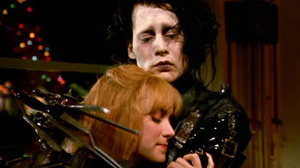Edward Scissorhands

The dawn of the blockbuster era began not with a bang, but with a single, thunderous opening crawl, and it was a revelation – a cultural earthquake that reshaped the landscape of Hollywood overnight. Drawing on mythic storytelling and swashbuckling serials, Star Wars offered an experience so visceral, so exhilarating, that audiences did not just watch it – they escaped into it. In an instant, the summer blockbuster, only recently redefined by Jaws, was transformed into something bigger: an event, a spectacle, a shared dream projected on an enormous screen. And audiences, still reeling from the gritty, introspective cinema of the 1970s, were ready for that dream.
It was a brief and brilliant moment: a convergence of artistic ambition, technological innovation, and studio support, where directors like Ridley Scott, James Cameron and Robert Zemeckis expanded on the foundations Spielberg and Lucas had laid before them, crafting films that pushed visual effects and genre boundaries without sacrificing identity or vision. From the late-1970s through the mid-1980s, blockbusters like Blade Runner, The Terminator, Back to the Future, and Aliens offered more than thrills – they offered imagination unbound. But the industry began to shift, increasingly driven by financial predictability, and the very concept of risk – the defining trait of early blockbusters like Alien and Raiders – was gradually replaced by the comfort of the familiar.
1989 became a quiet turning point – the year when the blockbuster era, in its original form, began to end, as the magic of discovery was slowly replaced by the assurance of familiarity. Terry Gilliam’s The Adventures of Baron Munchausen, released that spring, was a stunning act of defiance: imaginative, audacious, and utterly unmarketable. Like David Lynch’s Dune and Scott’s Legend before it, the film was misunderstood, too strange to survive in a business that was already tightening its margins. It now feels like a last gasp of a Hollywood that once gambled on mad genius – on dreamers who saw cinema not as content, but as myth-making.
Also from that spring, Phil Alden Robinson’s Field of Dreams, a nostalgic love letter to baseball and forgiveness, and Rob Reiner’s When Harry Met Sally, a sharply written masterclass in tone and timing released just a few months later, perfectly balanced a light touch with rich storytelling that allowed for thematic weight. These were character driven, mid-budget stories with emotional resonance and broad appeal that did not need spectacle to succeed, but no longer fit into a model which increasingly bet on high concepts.
Even within the traditional summer blockbuster season, endings loomed and movements emerged. Spielberg’s Indiana Jones and the Last Crusade arrived as a rousing heartfelt farewell – a final adventure rooted in physical stunts, practical effects, and old-school charm. It closed not just a trilogy, but an era when blockbusters could be handcrafted and human -scaled. And then came Spike Lee’s masterpiece Do the Right Thing, exploding onto screens with color, tension, and unapologetic political fire. In its moral ambiguity and stylistic confidence, it pointed toward the independent era of the 1990s.
Released between these two cultural touchstones was Tim Burton’s Batman. It was both a culmination and a prototype: a major studio event that also bore the fingerprints of an auteur. Burton, still early in his career, brought a stylized, gothic sensibility to the genre, and the results were visually radical. The film was a massive success in spite of its oddness, hinting at a refreshingly original cinematic future, and yet also marking Hollywood’s initial obsession with franchise building. It would be one of the few times a superhero film would feel like an artistic risk rather than a corporate strategy.
With the creative freedom and studio confidence now afforded the filmmaker, Burton would use the opportunity to bring a haunting, gothic fable to life, delivering the deeply personal and artistically groundbreaking Edward Scissorhands. A modern fairy tale, the narrative follows Edward, a gentle, artificial creation of an eccentric inventor who is left with scissors for hands when his elderly maker passes away before completing his transformation. Taken in by suburbia, Edward’s hands – a symbol of both his artistic genius and inability to assimilate – make him an instant outsider and a local sensation, embraced by the townspeople as a delightful novelty.
But the fascination doesn’t last, and when a misunderstanding leads to a manhunt by the town, Edward retreats back his mansion, becoming nothing more than a legend told to children on snowy nights. A critique of the way society embraces differences only when they are entertaining or useful, the film renders Edward’s downfall inevitable, as he will always be fundamentally incompatible with rigid expectations of normalcy. Yet, it is not a bitter ending, but rather a profoundly beautiful and melancholic one, suggesting an artist in exile creating beauty from a distance, shaping the snowfall that drifts down upon the town.
Emerging in 1989 with the studio-backed juggernaut Batman and returning in 1990 with the auteur-driven opus Edward Scissorhands, it is in many ways Burton himself who embodies the transition between the two decades. Today, Edward Scissorhands remains the director’s most personal, enduring, and beloved film, a timeless tale of innocence lost, individuality rejected, and beauty misunderstood, mirroring a film industry on the cusp of radical transformation. Before the movie studios had surrendered to CGI, franchise-dominated slates, and the elimination of mid-budget films, these pictures showed how Hollywood could successfully embrace eccentricity, standing as beautiful, bittersweet farewells to a vanishing era.
And as a footnote, the summer of 1989 would close with the release of James Cameron’s The Abyss, a visually mesmerizing blend of high-concept science fiction, groundbreaking special effects, and raw human emotion. The film is Cameron at his most ambitious, featuring water-based CGI which was a technological leap, yet it is its practical filmmaking and exploration of obsession, survival, and first contact that remains staggering. Despite its innovation, The Abyss received a lukewarm reception, overshadowed by its grueling production and ambiguous ending; a fitting coda to the blockbuster era that is now recognized as a flawed but awe-inspiring spectacle.
